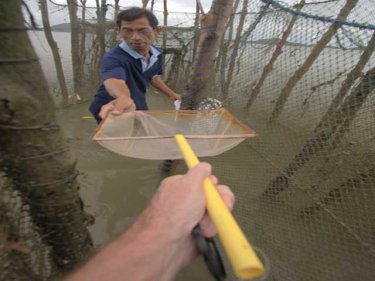WE ARE looking for box jellyfish off Phuket. At least, one of us is looking for box jellyfish.
The other three are hanging back and watching from a distance.
It is only when we are in the water, with Phuket City about four kilometres away across the mangroves, that we notice a difference in approach here.
The two marine scientists are in long trousers and shoes, while the two reporters are bare-legged and bare-footed.
Essentially, that's one of the key issues for anyone paddling around in the sea off Phuket these days: Is there something we should be told, for our own safety?
Box jellyfish are being found with regularity in the waters of Nam Bor Bay, on the island's south east coast, between the city's Saphan Hin garbage incinerator and Cape Panwa.
Today two are captured in the first mangrove stake box trap we visit, in water up to our knees.
More had been expected. Larger numbers have been captured and tipped into a bucket here most days recently.
Today, probably because of the height of the tide, we have to settle for two.
The discovery of box jellyfish off the coast of the holiday resort island is disconcerting and now poses a challenge for scientists and health authorities.
''This is all new to us,'' said Dr Somchai Bussarawit, the chief of the museum and aquarium at the Phuket Marine Biological Centre.
Waters in Australia and parts of Asia invariably contain dangerous creatures that are not found in European climes.
But the discovery of box jellyfish here has surprised and intrigued Dr Somchai and his hard-working colleague of 30 years, Surasit Utsaha.
Khun Surasit is using a net to dip for the transparent jellyfish, which are impossible to see in the stake trap.
The two he discovers are immature juveniles, with bodies smaller than tennis balls. Jellybabies, you could call them.
Are their stings dangerous? Dr Somchai smiles. That's a matter for further research, and something none of us are keen to find out for ourselves today.
Coincidentally, this beautiful spot is just a short drive down the road from the aquarium.
Box jellyfish have an awesome reputation as killers in northern Australia. But only a few deaths have been reported officially so far in Thai waters.
Strangely enough, the three known victims since 2002 have been an Australian, a Swiss and a Swedish girl off Koh Lanta in April.
With so many Thais in and around the same waters in much greater numbers, how is it there have not been more reports of many more deaths?
This is a question to be asked of the Thai health authorities.
As Dr Somchai points out more than once, he is a scientist. The priority of his team of marine biologists now is to find out all he can about the box jellyfish off Phuket and Krabi.
Has global warming contributed to the arrival of box jellyfish? Is it to do with too many fish being caught, reducing the natural predators? Could the toxic overflow from the garbage at Saphan Hin have something to do with it?
Dr Somchai bats away these questions. Science is his forte and he will wait to see first what Australian researchers have to say about the jellyfish, probably very soon
What Dr Somchai can say is that the box jellyfish have been found so far only in this particular stretch of mangroves off Phuket.
Although a Phuketwan reader described a jellyfish attack at Nai Harn earlier this year, he believes Phuket's popular Western beaches are clear of any kind of jellyfish danger.
Fishermen throughout the region are in the habit of alerting the centre to surprise discoveries, and the scientists are in touch regularly with public health officials.
It will be their decision as to what information needs to be conveyed to the public, at what stage in the research into the box jellyfish, and in what form.
Dr Somchai was able to tell us that one of the two varieties of box jellyfish, quite unusually, has a single eye and a single tentacle and is able to propel itself by swimming.
Box Jellyfish Found Off Phuket: Death in Krabi
The death of a tourist off Krabi and the discovery of a non-fatal form of box jellyfish off Phuket bring a call for help - and a claim that many more deaths go unrecorded.
Box Jellyfish Found Off Phuket: Death in Krabi










It certainly does seem odd that the three recorded deaths from box jellyfish are all foreigners. Surely some Thais must also go in the water and get fatally stung? Either the Thais are too smart to go in the water, or local deaths from box jellyfish simply go without being noticed. Surely the public health people must know the truth? They should speak out about the dangers
Posted by angelfire on October 22, 2008 22:22